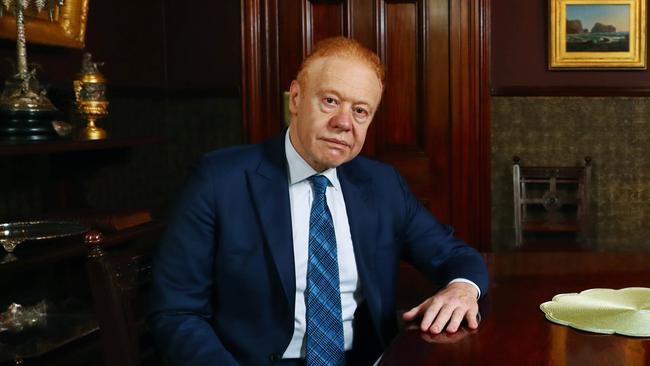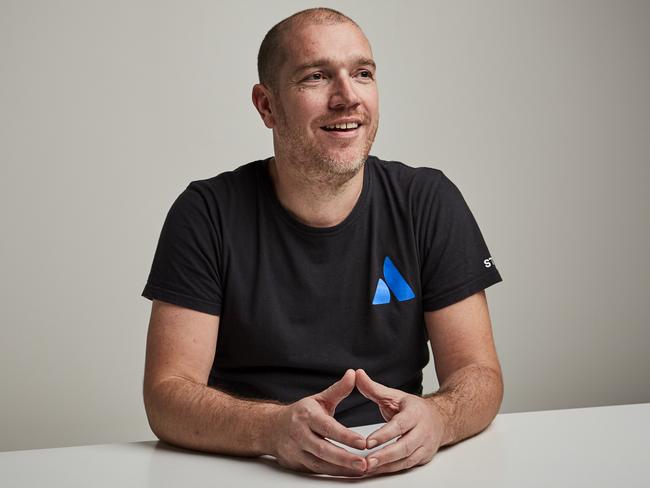Anthony Pratt, Andrew Liveris and Atlassian’s Dominic Price on the future of jobs
As Treasurer Josh Frydenberg conceded Australia is in recession, our reporters went in search of where the work might be for the nation’s unemployed.

As the immediate threat of the coronavirus passes, the biggest challenge facing economies is how to bring down unemployment, which has surged faster than ever.
The International Labour Organisation has forecast 195 million workers will lose their jobs in the coming months. In the US, more than 42 million workers have filed for jobless benefits.
The world has never dealt with a simultaneous supply-and-demand shock. Usually, either supply is hit, such as in the 1970s when oil prices leapt, or demand is affected, such as when confidence collapsed during the global financial crisis.
Traditionally, unemployment erodes slowly. In our previous recession in 1991, it took until late 1999 for the jobless rate to return to its pre-recession level of about 6.5 per cent. Most economists are expecting the same again or an even slower decline. Analysis by economists at New York University released last month found lockdowns were likely to induce an L rather than a V-shaped recession because of “long-lasting negative effects on unemployment”.
They found the “lockdown disproportionately disrupts the employment of workers who need years to find stable jobs”. Another US study found black and Latino Americans, who typically have fewer resources to begin with, could face jobless rates above 31 per cent, worse than the average. In Australia, the Melbourne Institute found “those most severely impacted by the economic shutdown are also those least able to cope with it”.
Emergency government support schemes could undermine the desire to see work too. For an estimated one million workers, JobKeeper payments of $1500 a fortnight will exceed their prior earnings. In the US, a new University of Chicago study found the median ratio of government income support to prior earnings was 134 per cent. “Two-thirds of workers eligible for unemployment insurance can receive benefits which exceed lost earnings, and one-fifth can receive benefits at least double lost earnings,” the authors say.
Looking ahead, industries where job losses have been greatest, in retail and hospitality, are likely to see the most enduring falls in their income as anxious households tighten their belts in anticipation of the unknown. Will there be a second wave of COVID-19? Uncertainty has never been so high. The first quarter national accounts revealed a jump in household saving that is bound to rise. Construction will need to shrink too if population growth, as expected, permanently falls as quarantine rules throttle immigration.
An accurate reading on unemployment will be hampered by official statistics that woefully understate the problem. The Australian Bureau of Statistics, in keeping with global practice, doesn’t count a person as unemployed if they are not ready to start work immediately or if they have not been looking for a job. That’s why the jobless rate in Australia has risen only to 6.2 per cent, even though 4.5 million workers are on some form of jobless benefit. The actual rate was closer to 15 per cent last month according to Roy Morgan, which uses a more relatable definition.
Governments have little incentive to reform the statistics, however. Indeed, they are likely to respond to mass unemployment by expanding their own payrolls, with dubious long-run benefits for productivity.
Meanwhile, young people will be encouraged into full-time study, where they aren’t counted as unemployed either.
Confidence will be key to a rapid rebound in employment. The lion’s share of job growth before the pandemic was in services, which are the first things to be cut back in times of uncertainty. Official readings suggest the worst of the fear is behind us, but widespread and lingering misinformation about the threat of the coronavirus poses to most people will likely see unemployment stay high for longer than need be.
-
Technology
Dominic Price, work futurist, Atlassian, talks to Glenda Korporaal

In less than 20 years of operation Atlassian created 4500 jobs around the world that didn’t exist before. What are some of the high-growth jobs in the company today?
We have hundreds of designers, product managers, marketing people and data analysts. Jobs around technology have the potential to be a massive growth area for Australia. Australia has the potential to be a leader in the tech sector. We don’t all need to leave for the US or live in Silicon Valley.
What are your projections for the jobs of the future?
I try not to make projections any more because the rate of change is too high. The nature of how we work is evolving with the impact of technology. Half of the jobs of the future I can’t even dream of. We just don’t know all the changes that are going to occur. The economy that made Australia successful during the past 50 years, which was about digging things out of the ground, may not be the same type of economy that thrives in the future. Take the role of data scientist. It is a role that didn’t exist five to 10 years ago. Now every tech company is hiring as many data scientists and artificial intelligence experts as it can.
When the internet came out, there was this massive explosion of information and data. Now everyone has terabytes of data. It is the role of data scientists to draw insights from it so we get meaningful information. Social media is the same. It is a job that didn’t exist when I was graduating. If we try to use a crystal ball, none of us can predict the jobs of the future and we will end up feeling uncomfortable. You really need to look at what are going to be the skills of the future. What do the skills of the future look like?
So, what sort of skills?
The soft skills around communications are going to surface again as being very powerful. The soft skills have become hard skills. The COVID-19 crisis, where people have moved to distributed workforces working from home around the country and not working together in offices, has shown that how and when we connect is more important than ever. The need for communication and emotional connectivity has increased. It’s not about STEM (science, technology, engineering and maths) any more, it’s about STEAM: science, technology, engineering, arts and maths. STEAM brings in the arts and creativity. If you have to solve problems, the balance of art and science becomes more important.
I guess your job — work futurist — is a job that didn’t exist a few years ago either?
Yes. I started work as an accountant with Deloitte in London.
Atlassian has always been interested in the idea of teams working together. It decided three years ago that it wanted to have a full-time person focusing on the future of work. There is immense interest in what the workplace of the future will look like and how the nature of how we work will evolve.
What do you see as the attributes of people who will be successful in creating the jobs of the future or being best prepared to move into the jobs of the future?
We all need to sign up for lifelong learning. I thought I was finished learning when I left university but I have learnt more in the past year than in the previous five years put together. We need to build the “muscle” of lifelong learning, from formal education to on-the-job training. Jobs are continually evolving. The role of a journalist, for example, is changing. Journalists are now using Twitter and LinkedIn, both of which didn’t exist years ago. At Amazon, founder Jeff Bezos recently put aside about $1bn to retain Amazon employees. He was saying we are going to be disrupted so how do we protect our people? Their role is changing. How do we reskill them?
What other attributes will the successful worker or employer of the future have?
We need to have the approach of sharing. The more a society shares, the better.
At Atlassian we have been working with the ANZ Bank helping them understand how we work the technology we use. The bank has more than 50,000 staff and its roots go back more than 160 years in Australia. We have 4500 people and we are only 17 years old. They are trying to learn from us, but we are also learning from them. In this modern environment, the more we can share across industry and companies, the more we can all benefit. A few years ago I sat down with (Atlassian founders) Scott (Farquhar) and Mike (Cannon-Brookes) and asked “What is the secret sauce of Atlassian? Why has it been so successful?” They said: “Why is it a secret? Let’s share it. Let’s give it away to every organisation for free. It’s the right thing to do.” So we documented our internal way of work in a team playbook, which is on our website. The more society shares, the better. We can all benefit.
-
Food & Agriculture
Anthony Pratt, executive chairman, Visy Industries, talks to John Stensholt

“The main two trends I’ve seen during this pandemic are that people are spending more of their income on food, and they are buying more online. There has been a lot of discussion about the return to manufacturing in Australia and how we should start making things such as face masks and ventilators. While I’m not getting into that debate, I would say that we have a competitive advantage in manufacturing food. And we should double down on the growing and manufacturing of food, which will create more jobs.
“Food is our biggest manufacturing sector today and represents 30 per cent of all manufacturing jobs — and Australia has a natural competitive advantage in growing things. We don’t need subsidies and tariffs to keep that part of the manufacturing sector growing.
“The Australian government has positioned us strongly lining up free trade agreements with many Asian nations — for example, Indonesia — and future FTAs, such as the UK, which provide us with further outlets for food manufacturing.
“To illustrate the worth of adding value to food by manufacturing it — if you sell wheat you get $100 per tonne. But if you turn it into flour you get $500 a tonne, and if you further manufacture it into bread you get $5000 per tonne.
“So I think we should focus on our free trade agreements. We need to export food as much as we can as the cornerstone of our manufacturing revival and I think we should import things we don’t have a competitive advantage in, so we avoid subsidising industries that are not economically viable. For this reason it’s good that the government is considering accelerated depreciation for investment — because currently 90 per cent of all company earnings are spent on share buy backs and dividends.
“On this note I’m proud to say Visy/Pratt Industries spend $500m a year on new machinery — which means more jobs. We already employ 15,000 people worldwide with an annual payroll of $1.5bn and, thanks to our emphasis on food packaging, these numbers continue
to grow.”
-
Manufacturing
Andrew Liveris, adviser, National COVID-19 Co-ordination Commission, talks to Glenda Korporaal

Where do you see the jobs of the future in manufacturing (or anywhere in industry)?
As supply chains and factories become digital, as existing factories get modernised and new modern factories get built, the skills to operate and build and deliver products and services to the consumer will be higher in technology content and geared to a human-machine interface. These jobs will no longer be categorised as white collar or blue collar but as “new collar” jobs. They will be higher quality, less physical and more interesting, They will be available to high school or university graduates. Education will need to be modified to allow access to all for these skills.
What areas and what sorts of jobs?
High-value skills in design, programming, project management, product development and similar value-add for a wide variety of sectors where Australia has foundation strengths. Areas such as biomed and health products, food and agribusiness processing, mining technology and services, energy-intensive industries such as hi-tech steel manufacturing, advanced building materials, fertiliser and explosives, chemicals and advanced materials and composites, and renewables and recycling sectors. And new capabilities such as 3-D printing, advanced sensors, robots and drones, visualisation technologies, advanced analytics and AI.
In the 20th century, jobs in manufacturing were replaced by cheap labour from China or Asia, so where are the jobs in 21st-century manufacturing?
The jobs outlined above are the 21st century’s high-quality jobs, highly paid and in high-margin sectors. These are quality jobs, not quantity jobs. They do not have a significant labour cost component.
Are we faced with a future of, say, 20 to 25 per cent unemployment with a chunk of skilled and well-paid professional workers and 20 to 30 per cent gig economy jobs that are casualised and lowly paid?
This is a common refrain. The precedent is the labour migration that occurred more than 100 years ago when we moved from an agrarian economy to an industrial economy. The education and training systems to bring all workers to the modern economy took more than a decade (to put in place). We can’t let this be the case in this migration. Universal training systems available to all have to be put in place. It will mean dislocation and funds being redirected.
he new sectors will create enough new jobs to accommodate all, just as the industrial revolution eventually did.
From your experience advising US presidents on manufacturing, what jobs have been created as the US brought more manufacturing back on shore?
Hi-tech vocations such as digital factory operators, precision welders, modular construction workers, warehouse operators, logistics schedulers, computer and internet maintenance technicians, and many other “trades” accompanied the often-mentioned “professional” categories of materials and other engineers, designers, computer programmers, software engineers, drone and robotic specialists.
-
Start-ups
It’s the young companies that create jobs, writes David Swan

Supporting high-growth technology businesses will be the key to Australia’s economic recovery post-COVID, according to Alex McCauley, former diplomat for the Department of Foreign Affairs and Trade, now chief executive of StartupAUS. He says data shows that young companies are by far the biggest driver of jobs in Australia: a 10-year study conducted by the federal government from 2001 to 2011 found that young companies created more than 1.4 million net new jobs.
During the same period, firms that had been around for more than five years shed about 400,000 jobs.
Almost 80 per cent of the new jobs came from high-growth young firms.
“Clearly if we want to drive rapid job creation we need to invest in helping people create and expand high growth young companies,” McCauley tells The Deal.
“That means reducing red tape, encouraging investment, and strengthening incentives to start a new business.
“We want more Australians to think about how they cannot only get a job but create one.”
According to McCauley, Canberra needs to incentivise people better to use and develop more technology at the core of their businesses, and think about how tech can help them attract customers in Australia and globally.
He says: “Take Canva, for example. Its online graphic design software was built in Sydney but it now serves customers in more than 150 countries.
“That has meant that in the eight years since the company was founded it has grown its Australian workforce to more than 500 staff and, despite COVID, is hiring for 35 Australia-based roles right now.
“As we start to wake up from the economic hibernation of COVID we will see green shoots starting to spring up.
“People all around the country with good ideas will look to start new businesses to meet shifts in demand, plug gaps that have emerged, and capitalise on new opportunity both local and global.
Encouraging and helping those people is the quickest path to rapidly re-engaging Australia’s workforce and delivering a strong, sustained recovery.”
The sentiments are echoed by a new state-based report from Deloitte Access Economics, which found that Victorian start-ups will continue to create thousands of high-skilled jobs and have the potential to play an important role in the state’s economic future in the wake of COVID-19.
The report found the Victorian technology start-up ecosystem had the potential to add on average 15,000 jobs each year to the broader Victorian economy across the next 20 years.
When the figures are extrapolated to include the rest of the Australia, it amounts to hundreds of thousands of jobs.
The report was commissioned by Victoria’s start-up support body LaunchVic, and its chief executive, Kate Cornick, says the start-up ecosystem will be a key pillar of economic stimulus post-COVID.
“The report shows that start-ups are creating thousands of high-skilled jobs year on year and as the start-up sector grows it will only become more valuable to our economy from a revenue and jobs perspective.”
-
Fashion
Glynis Traill-Nash looks beyond the designers for the new work in sales and marketing

Australian fashion is weighing up the potential to bring manufacturing back on shore but any return will take time and require investment in infrastructure. In the shorter term, there are two key areas of employment growth — digital roles and content creation.
“Digital agencies were one of the industries that outperformed throughout COVID,” says Richard Poulson, founder of Showroom-X, an e-commerce platform of premium Australian brands for the international market. “They were the ones everyone was calling on to fix this, upgrade that, and push people online if they weren’t already online. Consumers have had the luxury of being able to test the whole range of products and services online throughout COVID and have realised that it is in fact very easy to buy things online. And it’s very convenient.” Three or four e-commerce platforms now dominate, so Poulson suggests young people doing software development courses, for example, should just concentrate on those and “you will definitely get yourself a job”.
Brands have had to create their own content, from videos to photography, and collaborate with like-minded creatives to build a virtual world for consumers. Simon Lock, founder of Australian Fashion Week in the 1990s and the founder of digital wholesale platform Ordre, says content creation is one of two key areas of growth for the fashion industry. “Every videographer in the world is flat out right now,” Lock says. “Standard video, 360-degree video — the basis of any virtual reality experience — and then 3-D development and augmented reality, these content technology tools are really accelerating. Practitioners, contractors and innovators in these areas are going to benefit by that greater focus in the fashion industry.” Poulson says there is opportunity here for those in the creative industries to step up, and in particular for those recently retrenched by fashion magazines — stylists and journalists, for example — to work directly with brands.
Robyn Catinella has a Sydney-based PR and sales agency, and in a normal year she and her team hold showrooms in Paris and New York five times a year to showcase our designers. She has had to think outside the box and is working with a British company that specialises in virtual reality for the industry, to create her first VR showroom experience in July. It doesn’t use the VR headset but a potential buyer can scroll through the room with their cursor, approach a rack of clothes and make selections that will be hung on the VR rack as it would be in the physical showroom. When the buyer hovers over a piece of clothing, it can be pulled up in 3-D, and they can see additional information including “the history of the garment, its composition, and different price points”. They will have been sent fabric swatches ahead of the appointment so they can gauge the feel as they look at the picture.
The amount of travel in the industry was under scrutiny pre-COVID because of its environmental footprint. If this first VR showroom is successful, Catinella will consider replacing most of its international showrooms with this digital version permanently.
For Poulson, artificial intelligence is another area with opportunity for employment: “The kids of the future are going to be relying on AI so much more.They will want to be able to order by talking. That’s where we’re heading.”


To join the conversation, please log in. Don't have an account? Register
Join the conversation, you are commenting as Logout